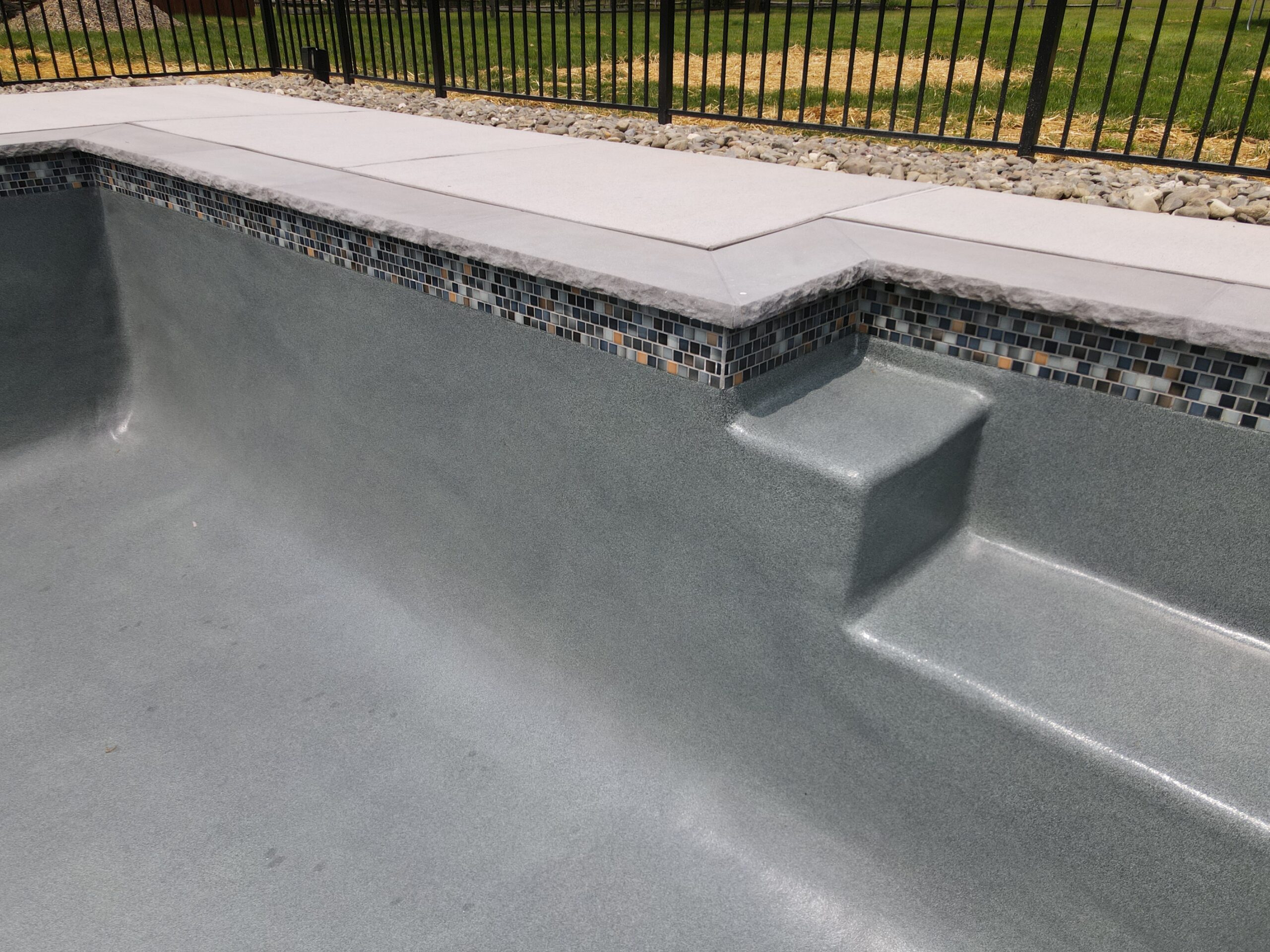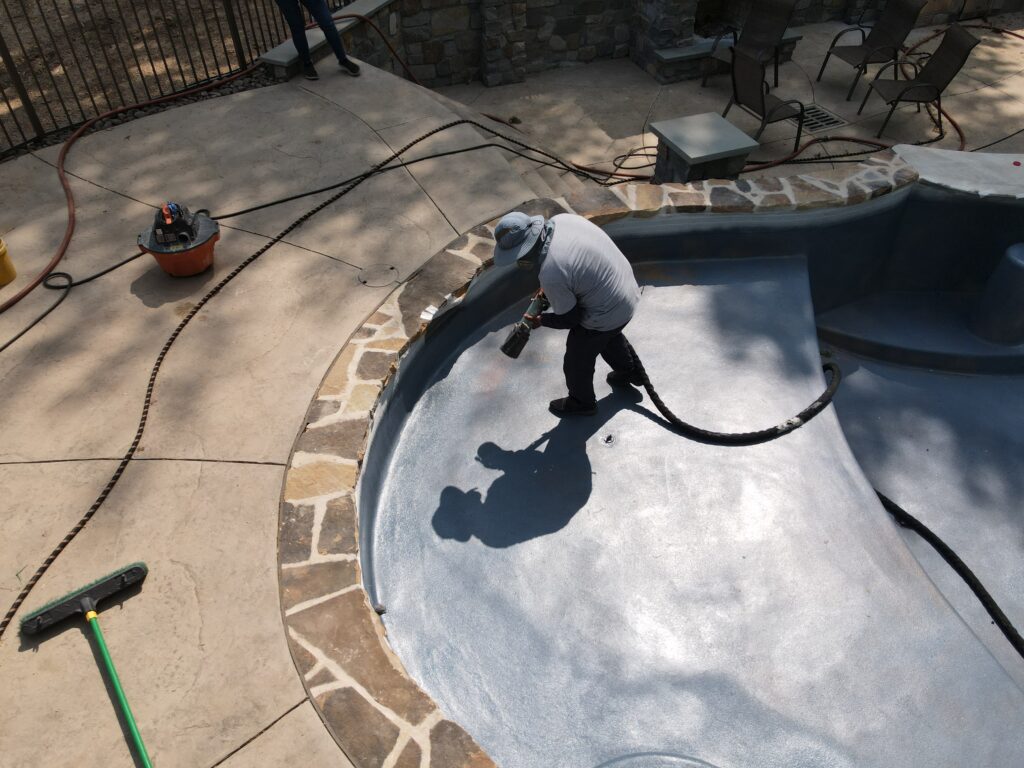
Introduction
If you’re considering revamping your pool’s surface or seeking a protective solution, you’ve likely encountered the term “pool epoxy paint.” In this comprehensive guide, we’ll go over pool epoxy from application to maintenance. Let’s discover how pool epoxy can not only transform your pool aesthetically but also shield it from wear and tear.
What Is Pool Epoxy Paint?
Definition
Pool epoxy paint is a coating designed to adhere to pool surfaces, offering a robust and enduring layer of protection. The magic of pool epoxy lies in its ability to create a highly polished, hard, and abrasion-resistant surface. Unlike traditional paints, pool epoxy is non-porous, providing enhanced protection against water and chemical damage. However, the application process is meticulous, involving a long drying period and considerations for weather conditions to avoid issues like milky discoloration.
Tips for Choosing the Right Pool Epoxy Paint
Consider Pool Type
The first step in choosing the right pool epoxy paint is to consider the type of pool you have. Whether it’s a concrete, fiberglass, or other material pool, the surface can impact the choice of epoxy paint. Some epoxy paints are specifically designed for certain pool types, so ensure you select one that is compatible with your pool’s surface to achieve the best results and long-lasting protection.
Evaluate Durability
Durability is a crucial factor when selecting pool epoxy paint. Look for epoxy paints that offer excellent resistance to UV rays, chemicals, and abrasion. A durable epoxy paint will not only protect your pool’s surface but also save you money in the long run by reducing the need for frequent recoating. Check for product specifications and reviews to assess the durability of the epoxy paint you’re considering.
Weather Considerations
Take into account the local climate and weather conditions in your area when choosing pool epoxy paint. If you live in a region with extreme temperature fluctuations, harsh sunlight, or severe weather, you’ll want to select an epoxy paint that can withstand these challenges. Look for epoxy paints with excellent weather resistance to ensure your pool finish remains vibrant and protective in any climate.
By considering your pool type, evaluating durability, and taking weather conditions into account, you can make an informed choice when selecting the right pool epoxy paint. This ensures that your pool remains beautiful and well-protected for years to come, regardless of the specific conditions it faces.

How to Use Pool Epoxy Paint
Draining and Debris Removal
One of the most important parts of the epoxy painting process is preparation. The first step involves draining the pool, ensuring a clean canvas for the transformative process ahead. Next, remove any debris to ensure there’s a surface ready for a smooth and flawless application.
Power Washing
With the pool emptied and debris cleared, it’s time to turn your attention to the pool’s surface. Next is the power washing stage. Grab your power washer and work to remove all existing paint. When complete, you should have a blank canvas that’s almost ready for painting.
Surface Treatment
As your pool surface gets a rejuvenating cleanse, it’s also the perfect opportunity to address any imperfections. This means sealing up cracks and applying an acid wash. This step can be the difference in a perfect application, so take the time to do this properly. This step is not just about aesthetics; it’s about ensuring optimal adhesion for the upcoming layers of protective epoxy.
Cleaning
Up next comes the application of trisodium-phosphate (TSP), a biodegradable, low-odor degreaser that clears out dirt, grease, and oils from the pool. This meticulous cleaning step ensures that every nook and cranny is free from contaminants, setting the stage for the grand finale — the application of pool epoxy paint.
Application
With the previous steps complete, it’s finally time to start applying the pool epoxy paint. Grab a roller and start painting the surface. Remember to be precise and patient with your application. Then allow sufficient drying time and before you know it, it will be time to refill the pool.
In these steps, your pool will undergo a major transformation. How close that transformation is to your desired vision will be dependent on the precision and effort put into each step. You can always consider professional help to ensure you get your desired look.
Benefits of Pool Epoxy Paint
Protection Against Damage
Pool epoxy paint is a solid choice when it comes to safeguarding your pool’s structure against potential damage. It forms a protective barrier on the pool’s surface, shielding it from the harsh elements it’s exposed to. Whether your pool is made of concrete, fiberglass, or other materials, epoxy paint can help prevent cracks, chips, and other forms of wear and tear that can occur over time.
This protective layer not only helps maintain the integrity of your pool but also contributes to its longevity. It acts as a barrier against water infiltration and prevents damage caused by exposure to UV rays, temperature fluctuations, and pool chemicals.
Vibrant and Attractive Finish
Pool epoxy paint has the ability to help you achieve a vibrant and attractive finish for your pool. Epoxy paints are available in a wide range of colors and finishes, allowing you to customize your pool’s appearance to match your personal style and preferences.
Its smooth, glossy surface not only visually enhances your pool, it also makes the water look even more inviting. This vibrant and attractive finish can turn your pool into a stunning centerpiece of your outdoor space.
Resistance to Fading and Chemicals
Pool epoxy paint stands out for its exceptional resistance to fading and the harsh chemicals used to maintain water quality in pools. UV rays from the sun can cause ordinary paint to fade over time, making the pool’s appearance less appealing. However, epoxy paint is formulated to withstand UV exposure, maintaining its color and vibrancy for years.
Additionally, pools require various chemicals to maintain proper water balance and hygiene. These chemicals can be harsh on the pool’s surface, causing damage and discoloration to regular paint. Epoxy paint, on the other hand, resists the corrosive effects of pool chemicals, ensuring that your pool maintains its fresh and inviting appearance while withstanding the challenges of water treatment.
Maintenance of Pool Epoxy Paint
Brushing and Filtering
Maintaining the beauty and integrity of your pool’s epoxy paint isn’t just about the initial application; it’s an ongoing process that involves some essential practices to keep your pool looking its best. Brushing and filtering are two critical aspects of this maintenance routine.
Regular brushing is essential to prevent the buildup of dirt, debris, and algae on the pool’s surface. The smooth, non-porous finish of epoxy paint makes it more challenging for contaminants to stick, but brushing still plays a crucial role in dislodging any potential trouble spots. Aim to brush your pool’s walls and floor at least once a week to keep it in pristine condition. Pay extra attention to areas with low water circulation, like steps and corners, as these are often hotspots for debris accumulation.
In addition to brushing, effective filtering is another essential element of pool epoxy paint maintenance. Your pool’s filtration system is what keeps the water clean and clear, and a well-maintained filter will go a long way in preserving the quality of the water and the longevity of the epoxy paint. Be sure to regularly clean and backwash your pool filter according to the manufacturer’s recommendations. This ensures that the filter is working at its best, preventing debris from settling on the pool surface and negatively impacting the epoxy paint.

Comparing Pool Epoxy Paint and ecoFINISH
Differences
When it comes to choosing a finish for your swimming pool, two popular options are Pool Epoxy Paint and ecoFINISH. While both offer excellent benefits, there are some key differences that can help you decide which is the better fit for your pool.
One fundamental difference is the application process. As you now know, Pool Epoxy Paint requires meticulous surface preparation before application. This includes sanding, priming, and applying multiple coats. On the other hand, ecoFINISH is a seamless thermoplastic finish that is applied as a liquid and then heated to create a strong, bondable surface. This application process makes ecoFINISH quicker and more efficient, with less disruption to your pool area during installation.
Another significant distinction is durability. Pool Epoxy Paint is known for its long-lasting protective qualities, offering resistance to UV rays, chemicals, and abrasion. While it provides excellent protection, it may require periodic recoating over the years to maintain its aesthetic appeal. It is durable as far as pool paint is considered, but it can’t compete with ecoFINISH products like aquaBRIGHT™ and polyFIBRO®, which are renowned for their exceptional durability. They are highly resistant to chipping, peeling, and fading, often lasting up to 15 years or more without the need for recoating.
Cost is also a factor to consider. Pool Epoxy Paint is typically more budget-friendly upfront, making it an attractive option for those looking for a cost-effective solution. However, when evaluating the long-term costs, including maintenance and recoating, ecoFINISH may be the more economical choice due to its extended lifespan and reduced need for ongoing maintenance.
Factors to Consider
Choosing between Pool Epoxy Paint and ecoFINISH for your pool comes down to several key factors that should be carefully considered to meet your specific needs and preferences.
If you’re looking for a quick and efficient installation process, ecoFINISH is the clear winner. It can be applied faster and with fewer disruptions to your pool area, making it a great choice for those who want minimal downtime.
Assess your long-term maintenance preferences. If you want a finish that requires minimal upkeep and lasts for an extended period without recoating, ecoFINISH is a strong contender. However, if you don’t mind periodic recoating and are looking for a more budget-friendly option upfront, Pool Epoxy Paint may suit your needs.
Consider the appearance you desire for your pool. Pool Epoxy Paint offers a range of color and finish options, allowing you to achieve the look you want. ecoFINISH also offers customization but in a slightly different way, as it comes in a variety of textures and colors. Determine which finish better aligns with your aesthetic goals.
Your budget is an important factor. While Pool Epoxy Paint may have a lower initial cost, it’s essential to account for long-term maintenance and recoating expenses. ecoFINISH, with its extended lifespan and reduced maintenance, can be a more cost-effective choice over time. They also offer warranties for residential and commercial pools.
In the end, the choice between Pool Epoxy Paint and ecoFINISH depends on your individual priorities, budget, and the specific characteristics that matter most to you. Both finishes offer advantages, so carefully weigh the factors that align with your pool project’s goals to make an informed decision.
Conclusion
In conclusion, pool epoxy paint stands as a transformative solution for homeowners seeking a durable, attractive, and long-lasting pool surface. By following our comprehensive guide, you can make informed decisions, avoid common pitfalls, and enjoy a pool that stands the test of time. Whether you’re a first-time user or considering a switch from alternative coatings, this guide equips you with the knowledge needed for a successful pool epoxy paint experience. Transform your pool and elevate your aquatic oasis to new heights.
